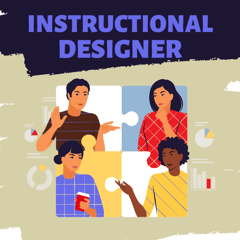A Day in the Life of an Instructional Designer

While the creation of learning events may seem fairly easy, there are several things that a good instructional designer will be able to accomplish that a person with even the most skilled expertise might miss.
Some might argue that someone who isn’t an expert would likely be able to represent the subject that needs to be taught.
The reality is, an instructional designer is professionally trained to be a blank slate to the content and makes no presumptions about the content, audience or situation so that a true reflection of what needs to be learned can be designed. An instructional designer is a true resource if you want to get to the heart of a training problem and make the solution “stick”.
Start the process: Getting the information, the audience, and the plan
An instructional designer starts their work by talking to the course sponsor, content owner, subject matter experts, and potentially (if they’re lucky) the learners. The instructional designer listens to everyone and takes in the information, but more importantly, they look for information that isn’t being said out loud. They aren’t looking for secrets, they're looking for the unspoken culture that makes a company and a team strong, that things that make the company hide the ‘sacred cows’, and what the subject matter expert (SME) might assume about the learner or the information being conveyed. An instructional designer will create a persona or a description of the learner to help guide the language and level of information being trained.
The work continues: designing and developing training
The next thing the ID will do is to create a design plan, a project plan, and a change management/communication plan. Planning is the secret to success as an instructional designer. The role requires tracking multiple people to create, review, and adapt content to fit the instructional strategy.
An instructional designer is going to take into account the organization’s culture, norms, communication style, and learning intentions. They will make sure that the information presented meets the needs of the learners rather than the language of the SME. They also ensure that the organization’s learning is going to meet organizational goals and measure learning to meet organizational KPIs.
Implementing the learning
Learning isn’t going to stick if it isn’t going to be realistic and reinforced throughout the organization. Instructional designers will make sure that all information presented meets instructional outcomes and gets measured in a way that empowers the individual learner and allows leaders to understand what needs to be coached, repeated, or adjusted.
Another part of the instructional designer’s role is to work with the sponsor to ensure communication is ready to talk about the reasons for implementing their training and create some urgency for completing it.
Evaluating an ongoing program
One of the many things instructional designers do is review and rework existing training. They do this by taking a look at how the training was previously delivered, creating spaces for the new content, and ensuring that all of the delivery is going to be impactful and useful.
Instructional designers may involve past or future learners who are currently doing the work needing training. They use surveys, focus groups, interviews, and observation to gather information and gaps in learning. Evaluating the needs of the learners and the gaps within the system is something that the instructional designer is comparing to previous measures as well as new measures that will work for the new training. It’s about what happened, what is missing, and where the organization needs to be in the future.
So, what tools? How does all this happen?
The instructional designer on your project is going to use many tools to help them ensure that they have all the information about the role and employees being trained and the content needed to build skills and knowledge and reinforce behaviours needed to make the company successful. They are also going to make sure the project stays on track by using many tools from project management like accountability charts, project plans, and other reporting tools. Finally, they are going to use templates specifically designed for the design and delivery of adult learning.
Ready to learn more, but not sure where to begin?
'Why are you the right Instructional Designer for us - Must ask interview questions'


